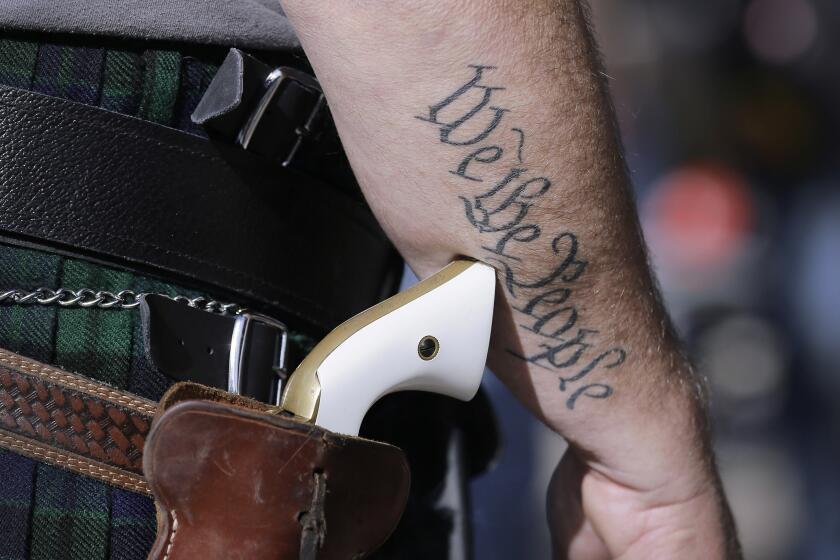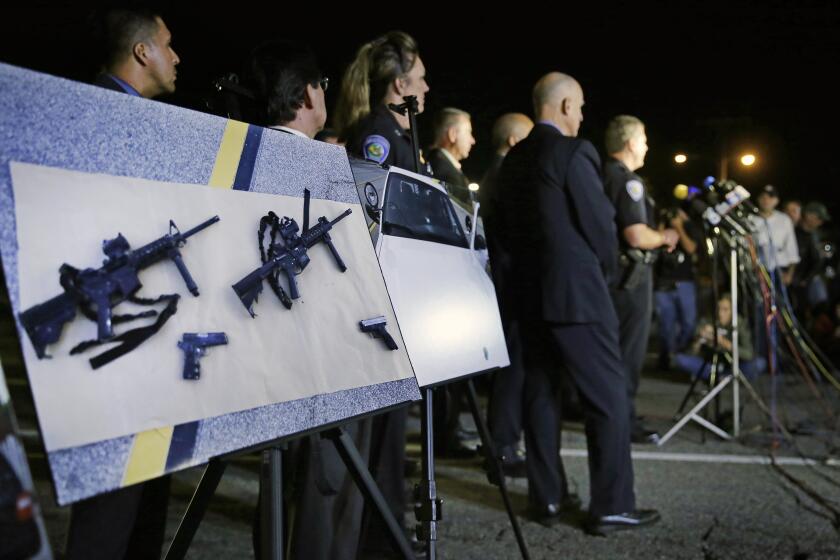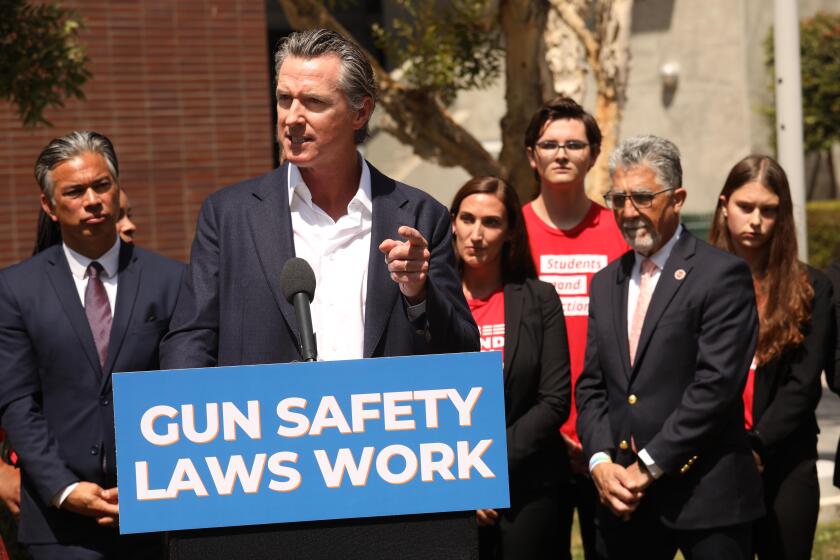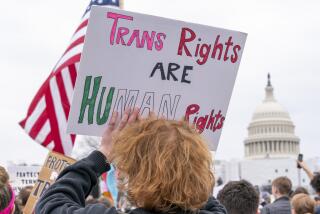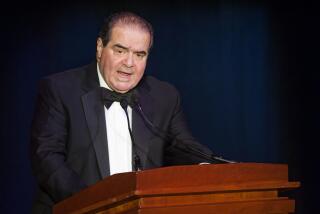Opinion: Even as mass shootings multiply, federal judges are erasing gun safety laws
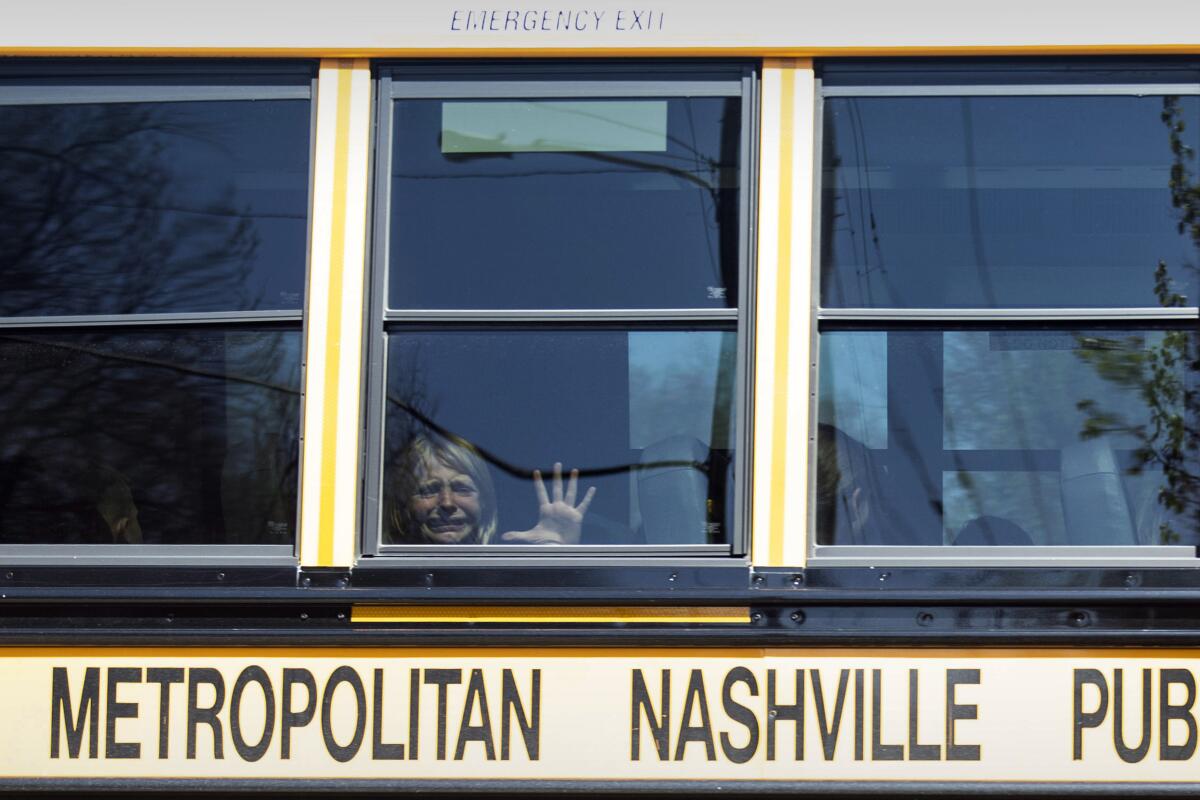
- Share via
Once again a mass shooting is in the headlines — this time in Nashville, with three children among the six victims. This latest horrific tragedy is prompting renewed calls for gun reform, but what most Americans don’t know is that a different kind of gun revolution is already underway.
Over the past few months, the federal courts have waged an unprecedented attack on U.S. gun safety laws. Spurred by the Supreme Court, judges have declared dozens of mainstream, widely accepted restrictions on firearms unconstitutional.
Even a partial list of the laws struck down or enjoined is startling: bans on possession of firearms by domestic abusers; bans on guns in churches, hospitals and bars; prohibitions on firearms in the hands of people charged with felonies; restrictions on 18-to-20-year-olds carrying weapons; prohibitions on loaded guns in vehicles; and bans on guns with obliterated serial numbers.
This tidal wave of rulings began with a decision by the Supreme Court last year. The justices struck down New York’s 100-year-old restrictions on who could obtain a license to carry a concealed firearm and established a new test for courts to apply in all 2nd Amendment cases. Many modern gun laws have been unable to survive it.
Now that the Supreme Court has tossed out a New York law limiting who can get a permit to carry a gun, California’s rules are on shaky legal ground.
A high court majority, led by Justice Clarence Thomas, said that gun laws today must be consistent with the gun laws of the 1700s and 1800s. Thomas’ rationale was grounded in originalism: Laws from 100 or 200 years ago reflected the original understanding of the 2nd Amendment (adopted in 1791) and the 14th Amendment (which expanded gun rights to the states in 1868), so they set the boundaries on what is constitutional.
The predictable result has been the demise of 20th century laws for 20th (and 21st) century reality. Take the federal ban on the possession of firearms by domestic abusers, which dated back a few decades. In voiding it, a judge in Texas explained that “glaringly absent from the historical record — from colonial times until 1994 — are consistent examples of the government removing firearms from someone accused (or even convicted) of domestic violence.” The fact that spousal abuse was often permitted by law in the 18th and 19th centuries didn’t matter.
Similar reasoning has been applied in cases from Oklahoma to New York. In striking down the ban on firearms whose serial numbers have been removed, a judge argued that since Congress first mandated serial numbers on firearms in 1968, there was no longstanding historical tradition of such laws. Because we did not ban guns on public transportation in the 1800s, another court said that a ban in airports and on buses was unconstitutional. Bans on guns in bars or hospitals? Again, no such laws existed back in the day, so such laws are impermissible infringements of the 2nd Amendment now.
Even when lawyers bring to court evidence of earlier gun laws similar to those being challenged, judges have twisted themselves in knots to deny the similarity exists.
Although Texas historically barred guns in “educational, literary, and scientific” institutions, that couldn’t justify a law today prohibiting guns in libraries and museums. Texas, a court said, had been an outlier in restricting guns in this way. In a case involving guns in churches, a judge dismissed several early American laws barring guns in places of worship because, despite the laws on the books, there was no evidence they had been consistently enforced in practice.
Thanks to the Supreme Court, cases challenging California’s gun laws have been focused more on distant history than the weapons’ modern threat.
Some of these decisions might be thought to be reflections of the extremism of a handful of Donald Trump-appointed lower court judges. Indeed, many of the cases declaring gun laws unconstitutional have been decided by federal district court judges nominated by the former president.
Nevertheless, the attack on gun safety laws is better understood as the result of a different set of Trump-appointed judges: Supreme Court Justices Neil Gorsuch, Brett Kavanaugh and Amy Coney Barrett, all of whom were known to have strong pro-gun views before they were nominated. As a lower court judge, Kavanaugh said that bans on assault weapons were unconstitutional and Barrett voted to strike down the lifetime ban on felons possessing firearms.
Barrett’s arrival, as the last of the Trump appointees, has been crucial. Until then, the high court had allowed reasonable restrictions that enhanced public safety, despite its 2008 determination that there exists an individual right to bear arms.
But just six months after Barrett took the oath of office, the court decided to hear the New York concealed carry case. All of Trump’s nominees, plus John Roberts and Samuel Alito, joined Thomas’ opinion establishing the new history-based test for 2nd Amendment cases.
It is possible that some of the recent gun rulings will be overturned on appeal. But the lower court decisions we’ve seen are not, by and large, outlandish applications of the Supreme Court’s test. In dismissing a charge of illegal possession of a firearm by a criminal defendant charged with a felony, a U.S. federal district court judge in Indiana, a Reagan appointee, expressed dismay at the result.
“This opinion was drafted with an earnest hope that its author has misunderstood” the Supreme Court’s decision. “If not,” the judge warned frankly, “most of the body of law Congress has developed to protect both public safety and the right to bear arms might well be unconstitutional.”
California lawmakers are trying again with a risky bill to restrict who can carry loaded weapons in public after the Supreme Court struck down restrictive concealed-carry laws.
Which gun laws are next? In truth, many of the most important and effective gun laws we have are without precedents from the 18th or 19th centuries. For example, laws barring convicted felons from having guns, requiring background checks on gun purchases and restricting access to firearms by people with mental illness are all modern-day innovations. Unsurprisingly, before there were easily portable machine guns, which were first introduced in the 1910s, there were no laws barring people from having such weapons.
The Supreme Court must take another 2nd Amendment case soon — and abandon or significantly revise its foolish history-based test. Today’s problems of gun violence are vastly different from those of the past. Prior to 1900s, cities were much smaller with much less urban gun crime. We recognize suicide today as a more serious problem than we did in the past. Early Americans didn’t even conceptualize mental illness the way we do, much less bar mentally ill people from possessing weapons.
The court must also make clear that a gun law’s effectiveness — not just its historical pedigree — matters. “Certainly, the usefulness of serial numbers in solving gun crimes makes [such a law] desirable for our society,” explained one judge. “But the Supreme Court no longer permits such an analysis.”
Meanwhile, gun violence is spiking in America. According to the Centers for Disease Control and Prevention, more Americans died of gun-related injuries in 2020 than in any other year on record. Gun homicides rose by 35% that same year, and has risen even more since. And the scourge of mass shootings continue; according to the Gun Violence Archive Nashville was the 129th since January (the archive has since added two more to its list).
So long as the Supreme Court insists that we combat these current problems with old, outdated tools, we will not be able to reduce gun violence. Indeed, if the justices do not act soon, there may be few gun laws left that even try.
Adam Winkler is a professor at UCLA School of Law and the author of “Gun Fight: The Battle Over the Right to Bear Arms in America.”
More to Read
A cure for the common opinion
Get thought-provoking perspectives with our weekly newsletter.
You may occasionally receive promotional content from the Los Angeles Times.
